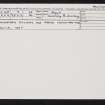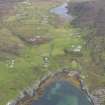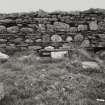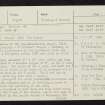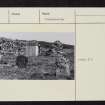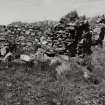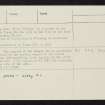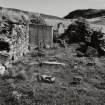Colonsay, Kilchattan, Old Parish Church And Well
Holy Well (Medieval), Parish Church (Medieval)
Site Name Colonsay, Kilchattan, Old Parish Church And Well
Classification Holy Well (Medieval), Parish Church (Medieval)
Alternative Name(s) St Catans Chapel, Kilchattan Burial Ground; Cille Chatan; St Cathan's Chapel
Canmore ID 37879
Site Number NR39NE 7
NGR NR 36290 95026
Datum OSGB36 - NGR
Permalink http://canmore.org.uk/site/37879
- Council Argyll And Bute
- Parish Colonsay And Oronsay
- Former Region Strathclyde
- Former District Argyll And Bute
- Former County Argyll
NR39NE 7 36290 95026.
(NR 3630 9501) Chapel (NR) (In Ruins)
OS 6" map (1900)
The remains of the pre-Reformation chapel, Cille Chatan, or Kilchattan - St Cathan's Chapel - standing on the site of its predecessor in its graveyard which was enclosed only a few years before 1880 and which is still in use.
The chapel measures 31' x 21' over rubble and lime walls which stand to a maximum height of 8', on the N side, which is complete. The whole of the W side, and half the S side have gone, so there is no trace of an entrance but it is said to have been in the W gable. The E end has an irregular gap which may have been a window.
In the graveyard are small cairns with headstones and footstones - the accepted method of covering a grave to protect it before the enclosing of the area.
What is believed to have been the holy water stoup was found near the E end of the church, and is now used as a baptismal font in the parish church at Scalasaig (NR 38 94).
The holy well 'Tobar Chattan' is situated on the croft of Druim Clach (NR 364 948) in the face of the bank opposite Kilchattan Church. The parish of Kilchattan in Colonsay is mentioned in 1632 (Orig Paroch Scot 1854). The dedication is to Catan (fl. c.600).
W Stevenson 1881; S Grieve 1923; J de V Loder 1935; W J Watson 1926
NR 3629 9502: The remains of the chapel are as described. There is no trace of the earlier chapel or the cairns which have been obliterated by later burials in the still used burial ground. A dry hollow at NR 3637 9497 probably represents the site of the well.
Surveyed at 1:2500.
Visited by OS (DWR) 16 April 1974
Field Visit (May 1977)
NR 362 950. The ruins of this medieval church stand within a walled burial-ground NW of the public road at Lower Kilchattan. They comprise portions of the side-walls and the E end-wall, which survives to a maximum internal height of 2.3m and was probably gabled. The walls measure 0.85m in average thickness, and are of random rubble masonry consisting of split boulders and slab pinnings laid in lime mortar. The structure was formerly oblong on plan, and the interior measures 8.3m in ascertainable length by 4.5m transversely; the extant portion of the s side-wall measures 4.5m in length. There are slight traces of the remainder of the S wall and possibly the W gable, but much of the area in and around the chapel has been disturbed by burials. The E wall contains the remains of the splayed ingoing of a central window which is flanked by a pair of lintelled aumbries. There is a similar splayed window-ingoing at the E end of the S side-wall, but there is no surviving evidence to indicate the position of the doorway.
This church can be identified as that which served the medieval parish of Colonsay, known as Kilchattan in the post-Reformation period. The dedication was evidently to St Catan, and these slight remains, which appear to be comparable to Teampull a'Ghlinne, Colonsay (RCAHMS 1984, No. 390), can be ascribed to the later Middle Ages, possibly to the later 14th century.
The church of Colonsay was confirmed to lona Abbey by a papal bull of 1203, but in the later Middle Ages the parsonage may have been attached to Oronsay Priory (OPS 1854; Cowan 1967, 34. The 1592 reference in the MS Register of the Privy Seal (SRO, PS 1/64, fol.20), cited by Cowan (loc. sit) is a presentation of Donald MacDuffie, in succession to Malcolm MacDuffie, titular prior of Oronsay, to the parsonage and vicarage of 'Orvinsay', but probably refers to this church.) The parish church is mentioned by Monro in 1549 (Munro 1884, 60), but it is not known how long the building remained in use for worship. The earliest dated funerary monument, located within the church, is a simple headstone inscribed 'EMV 1789'
RCAHMS 1984, visited May 1977.
Measured Survey (1977)
RCAHMS surveyed the church at Kilchattan in 1977 at a scale of 1:100. The plan was redrawn in ink and published at a reduced scale (RCAHMS 1984, fig. 33M, 194B).

















